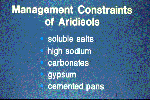 |
Availability of water is not the only constraint on the use of
Aridisols for agriculture. Soil horizons produced by arid climatic
conditions also affect the use of these soils. Soil management must
address these problem areas.
|
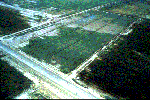 |
One of the most extensive problems facing irrigated agriculture
in arid regions is the presence of soluble salts in the soil in
amounts which inhibit plant growth. This aerial photograph shows
salt accumulation in fields and its effect on crop growth. Approximately
one-third of developed agricultural lands in arid regions reflect
some degree of salt accumulation.
|
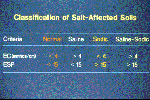 |
Salt affected soils are commonly classified for management purposes
into three groups; saline, sodic, and saline-sodic. Two criteria
are used for this classification, the electrical conductivity of
the soil saturation extract (EC) and the exchangeable sodium percentage
(ESP). Electrical conductivity is directly related to soluble salt
concentration in soils. The exchangeable sodium percentage is a
measure of the amount of sodium on soil exchange sites.
|
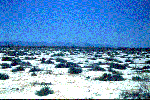 |
Saline soils often have a surface salt crust as seen here. Only
very salt tolerant plants can grow in such soils. As soil salinity
increases, soil water becomes less available to plants because of
higher osmotic pressures, even if soil moisture is plentiful.
|
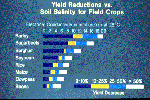 |
Plants vary widely in their tolerance to salts. This graph correlates
decreases in crop yields with salinity levels. Notice how barley
and sugar beets are much more tolerant of high soil salinity levels
than are cowpeas and beans. Today, plant scientists continue to
breed crop varieties that are increasingly tolerant to soluble salts.
|
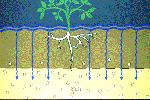 |
Saline soils can be reclaimed for agricultural use by leaching.
Leaching involves applying large volumes of water to the soil to
move soluble salts out of the rooting zone. To be effective, internal
soil drainage must be adequate so salts will not rise again into
the rooting zone.
|
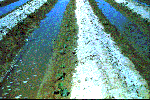 |
Seed placement is also important in the management of saline soils.
Under furrow irrigation soluble salts are concentrated toward the
crest of the bed. Therefore, optimum seed placement is on the lower
side of the bed, as seen here.
|

